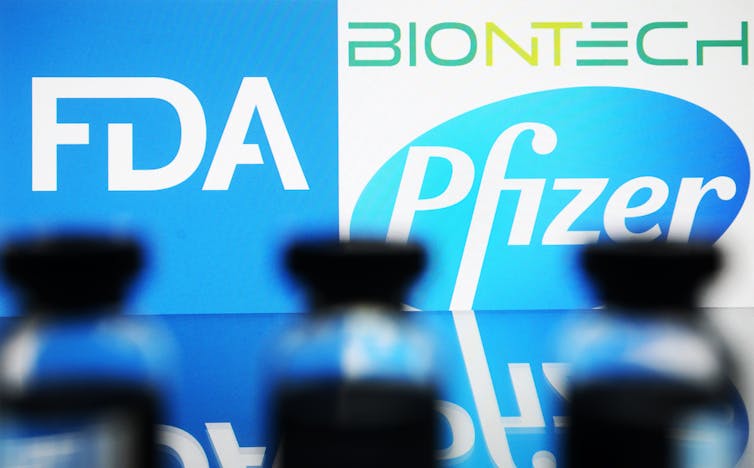What does full FDA approval of a vaccine do if it's already authorized for emergency use?
- Written by Jennifer Girotto, Associate Clinical Professor of Pharmacy Practice, University of Connecticut
Thirty percent of unvaccinated American adults[1] say they’re waiting for the COVID-19 vaccines currently authorized for emergency use to be officially approved by the U.S. Food and Drug Administration. That approval is expected within the next few weeks to months[2]. But what has to happen for the FDA to advance from emergency use authorization[3], or EUA, to full approval?
I’m a pharmacist[4] who trains other pharmacists, health care providers and students on why, when and how to administer vaccines. Emergency use authorization, while streamlining the regulatory process so the vaccine is more quickly available to the public, still follows a rigorous process[5] the FDA requires to ensure vaccine safety and effectiveness. The difference is that more time has passed and more data is available for review when a company applies for full approval.
All vaccines undergo five stages to ensure their safety and efficacy before approval.EUA and full approval share similar first steps
For both emergency authorization and full approval, for COVID-19 vaccines, the FDA first requires initial safety studies[6] on a small number of people. Here, researchers document potential adverse events, or side effects, that the vaccine may cause. Researchers also determine the safest and most effective dose of the vaccine.
Once the vaccine is determined to be safe and an optimal dose identified, researchers will create larger studies to ascertain how well it works in a controlled setting where some people are given the vaccine while others are given a placebo.
It is important to note that the number of people who participated in the initial COVID-19 safety studies was similar to that in the safety studies of other commonly used vaccines, including vaccines for tetanus, diphtheria, whooping cough and meningitis[7]. Over 43,000 adults participated in the early phases of the Pfizer BioNTech[8] clinical trial, over 30,400 in Moderna’s[9] and over 44,000 in Johnson and Johnson’s[10]. Half the participants in each study were given a vaccine, while the other half were given a placebo.
Where EUA and full approval differ
From this point on, emergency use authorization and full FDA approval for COVID-19 vaccines follow different clinical study requirements.
For the emergency use authorization[11], the FDA requires at least half of the participants of the original studies to be followed for at least two months post-vaccination. This is because the vast majority of vaccine-related side effects occur right after vaccination[12].
Full FDA approval, on the other hand, requires participants in the original studies to be followed for at least six months[13]. Reviewers look at data from the same study participants but collected over a longer period of time. All adverse events are examined. The manufacturer must also provide more detailed manufacturing plans and processes, as well as a higher level of oversight and inspections. All of this adds significantly more time to the review process.
 Full FDA approval involves reviewing more data after a longer observational period.
SOPA Images/LightRocket via Getty Images[14]
Full FDA approval involves reviewing more data after a longer observational period.
SOPA Images/LightRocket via Getty Images[14]
Both Pfizer[15] and Moderna[16] began their rolling submission for approval in the FDA’s “Fast Track” process[17], designed to speed up review. This allows the companies to submit portions of their approval application to the FDA for review as they’re completed.
Full FDA approval will likely apply initially to only the same age groups that were tested in the original emergency use authorization. This means that the vaccine will likely be approved first for people ages 16 and up for Pfizer and 18 and up for Moderna. Rolling submission will allow approval of the vaccine for younger groups as more data becomes available.
Different timelines, same rigorous requirements
Full FDA approval is a milestone that may help build confidence among the vaccine hesitant about the safety of the vaccines. But the true test of the vaccine came when it first gained emergency use authorization. Then, researchers identified the majority of its potential side effects and proved its ability to protect against severe disease.
[Like what you’ve read? Want more? Sign up for The Conversation’s daily newsletter[18].]
References
- ^ Thirty percent of unvaccinated American adults (www.kff.org)
- ^ few weeks to months (www.nytimes.com)
- ^ emergency use authorization (www.fda.gov)
- ^ pharmacist (scholar.google.com)
- ^ rigorous process (www.fda.gov)
- ^ initial safety studies (www.fda.gov)
- ^ tetanus, diphtheria, whooping cough and meningitis (doi.org)
- ^ Pfizer BioNTech (doi.org)
- ^ Moderna’s (doi.org)
- ^ Johnson and Johnson’s (doi.org)
- ^ emergency use authorization (www.fda.gov)
- ^ occur right after vaccination (www.verywellhealth.com)
- ^ followed for at least six months (www.fda.gov)
- ^ SOPA Images/LightRocket via Getty Images (www.gettyimages.com)
- ^ Pfizer (www.pfizer.com)
- ^ Moderna (investors.modernatx.com)
- ^ “Fast Track” process (www.fda.gov)
- ^ Sign up for The Conversation’s daily newsletter (theconversation.com)
Authors: Jennifer Girotto, Associate Clinical Professor of Pharmacy Practice, University of Connecticut


